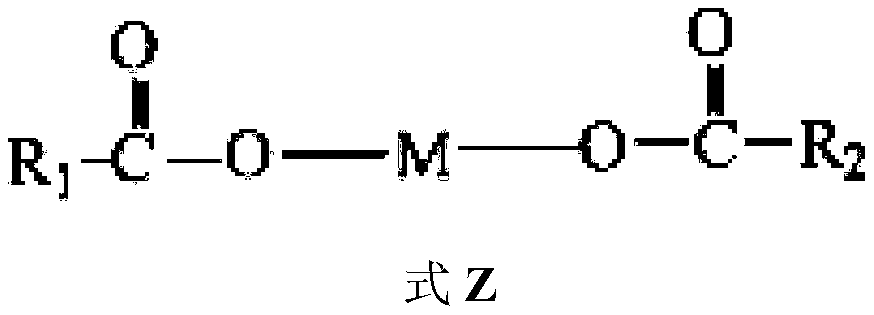Preparation method of solid catalyst component for olefin polymerization, olefin polymerization catalyst and application thereof
A solid catalyst and olefin polymerization technology, applied in the field of olefin polymerization catalysts, can solve the problems of rapid catalyst activity decay, isotacticity and hydrogen adjustment performance to be improved, and catalyst performance has a greater impact
- Summary
- Abstract
- Description
- Claims
- Application Information
AI Technical Summary
Problems solved by technology
Method used
Image
Examples
preparation example Construction
[0023] In a first aspect, the present invention provides a method for preparing a solid catalyst component for olefin polymerization, comprising the steps of:
[0024] 1) dissolving the magnesium halide in a solvent system preferably consisting of an organic epoxy compound, an organic phosphorus compound and an inert diluent to form a solution;
[0025] 2) contacting the solution obtained in step 1) with a precipitation aid and a titanium compound to produce a mixture containing solid precipitation,
[0026] The precipitation aid includes the compound shown in formula A,
[0027]
[0028] In Formula A,
[0029] m 1 to M 12 The same or different, each independently selected from hydrogen, hydroxy, halogen, cyano, nitro, amino, mono-C 1 -C 10 Alkylamino, bis-C 1 -C 10 Alkylamino, aldehyde, carboxyl, R a C(O)-, R a O-, C 1 -C 10 Alkyl, C 2 -C 10 Alkenyl, C 2 -C 10 Alkynyl, C 3 -C 8 Cycloalkyl, C 6 -C 20 Aryl, C 7 -C 20 Aralkyl, 4-12 membered heterocycloalk...
Embodiment approach
[0089] According to some embodiments of the present invention, the preparation method also includes the following steps:
[0090] 3) contacting the mixture containing solid precipitation obtained in step 2) with an internal electron donor compound to obtain a solid containing magnesium and titanium;
[0091] Optionally, 4) treating the magnesium- and titanium-containing solid obtained in step 3) with a mixture of a titanium compound and an inert diluent, and then washing with an inert diluent to obtain the solid catalyst component.
[0092] According to some embodiments of the present invention, in step 3), firstly, the temperature of the mixture containing solid precipitation is raised to 60-110°C, and the internal electron donor compound is added during the heating process or after the temperature is raised to 60-110°C, preferably the temperature is raised to After 60-110°C, the reaction is continued for 0.2-8 hours, and then solid-liquid separation is carried out, and the s...
Embodiment 1
[0148] In the reaction kettle that has been repeatedly replaced by high-purity nitrogen, add 0.05 moles of anhydrous magnesium chloride, 0.75 moles of toluene, 0.1 moles of epichlorohydrin, and 0.033 moles of tributyl phosphate in sequence. , reacted for 2 hours, added 2.5 mmoles of compound A diluted with 0.1 moles of toluene, reacted for 1 hour, cooled to -28°C, added dropwise 0.51 moles of titanium tetrachloride, continued to react for one hour, and gradually raised the temperature to 85°C. Precipitate solid particles, add 4.0 mmol DNBP, keep the temperature for one hour, filter the mother liquor, wash and filter the liquid with inert diluent toluene several times, add 0.44 moles of titanium tetrachloride, 0.7 moles of toluene, keep the temperature at 110 ° C for 2 hours, filter Repeat the treatment twice more, and then wash with hexane for 5 times, and the remaining solid product is vacuum-dried to obtain a solid titanium catalyst component.
PUM
 Login to View More
Login to View More Abstract
Description
Claims
Application Information
 Login to View More
Login to View More - R&D
- Intellectual Property
- Life Sciences
- Materials
- Tech Scout
- Unparalleled Data Quality
- Higher Quality Content
- 60% Fewer Hallucinations
Browse by: Latest US Patents, China's latest patents, Technical Efficacy Thesaurus, Application Domain, Technology Topic, Popular Technical Reports.
© 2025 PatSnap. All rights reserved.Legal|Privacy policy|Modern Slavery Act Transparency Statement|Sitemap|About US| Contact US: help@patsnap.com



